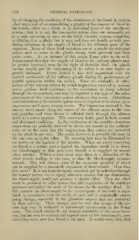Page 662 - My FlipBook
P. 662
G72 GENERAL PATHOLOGY.
bie of changing the condition of the circulation of the blood in various
other ways, and of accommodating a greater or less amount of blood in
the vessels, either as a whole or in individual parts of the circulatory
system ; that is to say, the vaso-motor system does not necessarily act
as a unit, operating at once on the whole vascular system, expanding
or dilating it as a whole, but it may and does act locally as well, pro-
ducing variations in the supply of blood to the different parts of the
organism. Many of these local variations are of a purely physiological
nature, such as occur in the glands during their quiescent and their
active states. As an instance of this action I may refer to the well-
demonstrated fact that the supply of blood to the salivary glands may
be greatly increased, even by the sight of desirable food : the glands
become turgid, and the outpouring of the saliva is at once begun or
greatly increased. Every dentist is also well acquainted with the
marked excitement of the salivary glands during the performance of
painful operations within the mouth. These are examples of reflex
actions of the nervous system by which impressions received by sensory
nerves produce local variations in the circulation by being reflected
through the vaso-motors, and may be regarded as the type of the reflex
phenomena of the vaso-motor system wherever they occur. Dilatations
and contractions of the vascular system occur in response to irritation of, or
impressions made upon, sensory nerves. The impression received by the
sensory nerve passes along the course of the afferent nerve to the cen-
tral ganglion, and from thence is reflected back through the efferent
nerve as a motor impulse. This statement holds good in both normal
and abnormal conditions. In the mechanism of the nutritive functions
impressions are probably received by nerves not sensory in the ordinary
sense or in the sense that the impresssions they convey are perceived
by the mind in any way. The result, however, is precisely the same in
tlie one case as in the other. My meaning here may be illustrated by
the results of the ligation of the arteries. When an artery conveying
the blood to a certain part is ligated the immediate result is to lessen
the blood-supply to that part, even though it is supplied by several
other arteries. Within a very short time there is a dilatation of the
other vessels leading to the part, so that the blood-supply becomes
normal. This will always occur if the necessary quantity of blood
can be supplied by a reasonable expansion of these vessels. How does
this occur? It is not from the injury sustained and by reflection through
the sensory nerves, for an injury otherwise similar, but not diminishing
the blood-supply, would not produce a similar effect. Then the effect
must be produced by other nerves that take cognizance of the nutritive
])rocesses and reflect the needs of the tissues for the nutritive fluid. In
this manner the blood-supply to the several parts of tlie body is regu-
lated in accordance with the needs of each, and is continually under-
going change, especially in the glandular organs that are periodical
in their activity. These changes may be seen also in any of the tis-
sues that may be subjected to microscojjic examination in tlie living
state. The small arteries do not remain uniformly of the same diam-
eter, but are seen to contract and expand more or less continuously, now
admitting more, now less, blood to the part. It would seem, then, that


